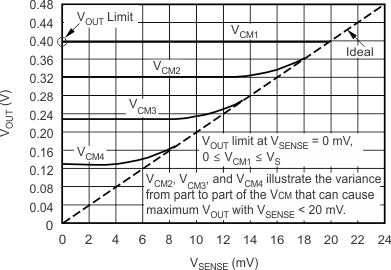SBOS938C October 2018 – June 2020 INA901-SP
PRODUCTION DATA.
- 1 Features
- 2 Applications
- 3 Description
- 4 Revision History
- 5 Pin Configuration and Functions
- 6 Specifications
- 7 Detailed Description
- 8 Application and Implementation
- 9 Power Supply Recommendations
- 10Layout
- 11Device and Documentation Support
- 12Mechanical, Packaging, and Orderable Information
Package Options
Mechanical Data (Package|Pins)
- HKX|8
Thermal pad, mechanical data (Package|Pins)
Orderable Information
7.4.2.4 Low VSENSE Case 2: VSENSE < 20 mV, 0 V ≤ VCM ≤ VS
This region of operation is the least accurate for the INA901-SP. To achieve the wide input common-mode voltage range, this device uses two op amp front ends in parallel. One op amp front end operates in the positive input common-mode voltage range, and the other in the negative input region. For this case, neither of these two internal amplifiers dominates and overall loop gain is very low. Within this region, VOUT approaches voltages close to linear operation levels for Normal Case 2.
This deviation from linear operation becomes greatest the closer VSENSE approaches 0 V. Within this region, when VSENSE approaches 20 mV, device operation is closer to that described by Normal Case 2. Figure 18 shows this behavior for the INA901-SP. The VOUT maximum peak for this case is determined by maintaining a constant VS, setting VSENSE = 0 mV, and sweeping VCM from 0 V to VS. The exact VCM at which VOUT peaks during this case varies from device to device. The maximum peak voltage for the INA901-SP is 0.4 V.
